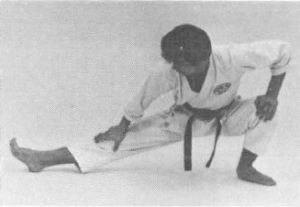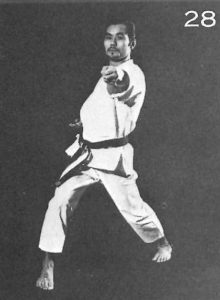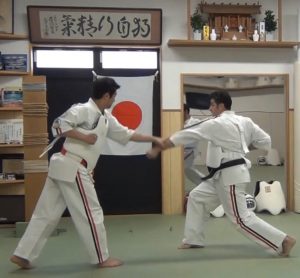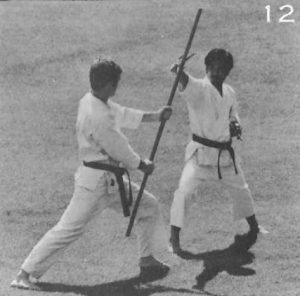Training (English)
The founder, Masayoshi Kori Hisataka, Kensei 10th dan, systematically organized Shorinjiryu Kenkokan Karatedo’s practice to include certain key aspects, primarily Kihon-waza, Kata, Kumite, Bunkai-kumite, and Buki-ho.
1. Warming up exercises
Similar to any other strenuous physical activity or sport, Karate practitioners need to warm-up and cool-down before and after practice.
any other strenuous physical activity or sport, Karate practitioners need to warm-up and cool-down before and after practice.
Practice starts from “Kihon-waza” (basic techniques), including basic punching, kicking, and striking techniques, standing forms such as cat stance (neko ashi dachi), front stance (zen kutsu dachi), Back stance (kokutsu dachi) etc.
2. Form
 Following practice of the basic techniques, students proceed to practice the special karate forms called “Kata”. Like shadowboxing, Kata are practiced by oneself without a partner. Kata involve punching, kicking, striking, and using other techniques (including blocking, evading and grappling) against imagined opponents. Kata are the cultural inheritance of karatedo, developed by our predecessors as a means of practicing the complete curriculum of Karate techniques which they developed through actual combat. Kata enabled these people to structure their own battlefield techniques into forms which could be practiced as well as taught to pupils secretly since ancient times.
Following practice of the basic techniques, students proceed to practice the special karate forms called “Kata”. Like shadowboxing, Kata are practiced by oneself without a partner. Kata involve punching, kicking, striking, and using other techniques (including blocking, evading and grappling) against imagined opponents. Kata are the cultural inheritance of karatedo, developed by our predecessors as a means of practicing the complete curriculum of Karate techniques which they developed through actual combat. Kata enabled these people to structure their own battlefield techniques into forms which could be practiced as well as taught to pupils secretly since ancient times.
3. Combat drills
The next critical element of Karate practice is “Kumite”. Kumite, separated into pre-arranged combat drills involving more than one person (“Yakusoku randori kumite”) and free sparring (“Jiyu kumite”), allows participants to practice actual attacks and counterattacks with one or more partners, enabling them to study the “suitable distance” (“Maai”) and “timing” required for Karatedo, as well as “the law of offense and defence “.
 In practicing Jiyu kumite, Shorinjiryu Kenkokan Karatedo dojos use “Super Safe” protective equipment (head and body protectors) to enable participants to execute techniques with full power while maintaining safety. Since a purpose of Karate training is to build health and vitality even into old age, it is important to train safely and with minimal risk of injury. Therefore, all people, young and old of both sexes, can safely train Shorinjiryu Kenkokan Karatedo and master useful techniques with proper distance and power because of the use of “Super Safe” equipment.
In practicing Jiyu kumite, Shorinjiryu Kenkokan Karatedo dojos use “Super Safe” protective equipment (head and body protectors) to enable participants to execute techniques with full power while maintaining safety. Since a purpose of Karate training is to build health and vitality even into old age, it is important to train safely and with minimal risk of injury. Therefore, all people, young and old of both sexes, can safely train Shorinjiryu Kenkokan Karatedo and master useful techniques with proper distance and power because of the use of “Super Safe” equipment.
4. Pre-arrange combat drills
In Yakusoku randori kumite, a concept originally developed by Kaiso Hisataka, attacks and counterattacks are defined beforehand, and the participants work together to continuously perfect their techniques.This training system, unique to Shorinjiryu Kenkokan karatedo, allows two, three or more persons to work together at the same time and develop their techniques in safety.
5. Application of Kata
Another important element of Shorinjiryu Kenkokan Karatedo is “bunkai-kumite”. Bunkai-kumite deconstructs and explains each movement of classic Kata by organizing them into sequences of techniques (resembling Yakusoku randori kumite) to be practiced with opponents. The practice of Bunkai-kumite is very important to grasp the real techniques of the Kata, which are themselves the “alphabet” making up the language of Karatedo.
6. Weapons
 There is a metaphor that the fist and foot of Karatedo should be sharp and keen like weapons that will “cut anything they touch”. To truly master the principles of offense and defense, studying only the structure of punching, kicking and striking is not enough. To really understand the original meaning of Karatedo, it is essential to also practice “Buki-ho” (the way of weapons). Senior students (Yudansha) of Shorinjiryu Kenkokan Karatedo must practice Buki-ho such as Bo-jitsu (the art of the staff) to understand long distance fighting and Ken-jitsu (the art of the sword) to understand middle distance fighting. And also Sai-jitsu (the art of short trident) to understand short distance fighting.
There is a metaphor that the fist and foot of Karatedo should be sharp and keen like weapons that will “cut anything they touch”. To truly master the principles of offense and defense, studying only the structure of punching, kicking and striking is not enough. To really understand the original meaning of Karatedo, it is essential to also practice “Buki-ho” (the way of weapons). Senior students (Yudansha) of Shorinjiryu Kenkokan Karatedo must practice Buki-ho such as Bo-jitsu (the art of the staff) to understand long distance fighting and Ken-jitsu (the art of the sword) to understand middle distance fighting. And also Sai-jitsu (the art of short trident) to understand short distance fighting.
The original purpose of true Okinawan Karatedo was to protect the lives of oneself and one’s family. For this reason, Shorinjuryu Kenkokan Karatedo includes a study of how to fight against Katana (sword) using only one’s bare hands and feet, as well as with a Bo (staff) or Sai (short trident). To learn Buki-ho is one of the most important basics of true Karatedo.